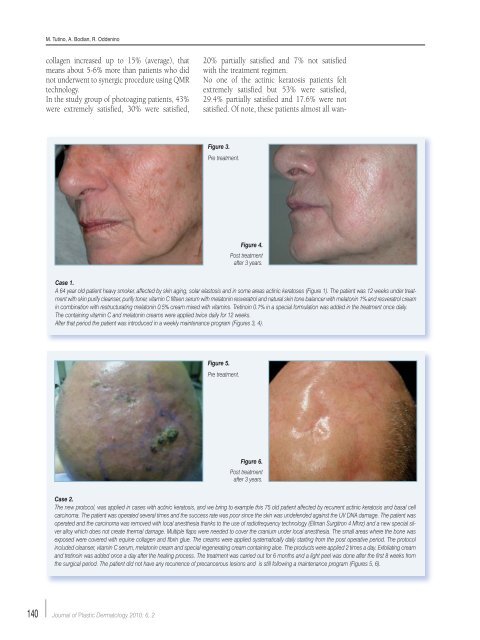Cop ISPLAD - Salute per tutti
Cop ISPLAD - Salute per tutti
Cop ISPLAD - Salute per tutti
You also want an ePaper? Increase the reach of your titles
YUMPU automatically turns print PDFs into web optimized ePapers that Google loves.
140<br />
M. Tutino, A. Bodian, R. Oddenino<br />
collagen increased up to 15% (average), that<br />
means about 5-6% more than patients who did<br />
not underwent to synergic procedure using QMR<br />
technology.<br />
In the study group of photoaging patients, 43%<br />
were extremely satisfied, 30% were satisfied,<br />
Journal of Plastic Dermatology 2010; 6, 2<br />
20% partially satisfied and 7% not satisfied<br />
with the treatment regimen.<br />
No one of the actinic keratosis patients felt<br />
extremely satisfied but 53% were satisfied,<br />
29.4% partially satisfied and 17.6% were not<br />
satisfied. Of note, these patients almost all wan-<br />
Figure 3.<br />
Pre treatment.<br />
Figure 4.<br />
Post treatment<br />
after 3 years.<br />
Case 1.<br />
A 64 year old patient heavy smoker, affected by skin aging, solar elastosis and in some areas actinic keratoses (Figure 1). The patient was 12 weeks under treatment<br />
with skin purify cleanser, purify toner, vitamin C fifteen serum with melatonin resveratrol and natural skin tone balancer with melatonin 1% and resveratrol cream<br />
in combination with restructurating melatonin 0.5% cream mixed with vitamins. Tretinoin 0.1% in a special formulation was added in the treatment once daily.<br />
The containing vitamin C and melatonin creams were applied twice daily for 12 weeks.<br />
After that <strong>per</strong>iod the patient was introduced in a weekly maintenance program (Figures 3, 4).<br />
Figure 5.<br />
Pre treatment.<br />
Figure 6.<br />
Post treatment<br />
after 3 years.<br />
Case 2.<br />
The new protocol, was applied in cases with actinic keratosis, and we bring to example this 75 old patient affected by recurrent actinic keratosis and basal cell<br />
carcinoma. The patient was o<strong>per</strong>ated several times and the success rate was poor since the skin was undefended against the UV DNA damage. The patient was<br />
o<strong>per</strong>ated and the carcinoma was removed with local anesthesia thanks to the use of radiofrequency technology (Ellman Surgitron 4 Mhrz) and a new special silver<br />
alloy which does not create thermal damage. Multiple flaps were needed to cover the cranium under local anesthesia. The small areas where the bone was<br />
exposed were covered with equine collagen and fibrin glue. The creams were applied systematically daily starting from the post o<strong>per</strong>ative <strong>per</strong>iod. The protocol<br />
included cleanser, vitamin C serum, melatonin cream and special regenerating cream containing aloe. The products were applied 2 times a day. Exfoliating cream<br />
and tretinoin was added once a day after the healing process. The treatment was carried out for 6 months and a light peel was done after the first 8 weeks from<br />
the surgical <strong>per</strong>iod. The patient did not have any recurrence of precancerous lesions and is still following a maintenance program (Figures 5, 6).

















